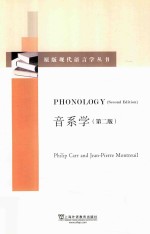
- 作 者:菲利普·卡尔,让-皮埃尔·蒙特勒伊(Philip Carr,Jean-Pierre Montreuil)著
- 出 版 社:上海:上海外语教育出版社
- 出版年份:2016
- ISBN:7544645799
- 标注页数:338 页
- PDF页数:354 页
请阅读订购服务说明与试读!
订购服务说明
1、本站所有的书默认都是PDF格式,该格式图书只能阅读和打印,不能再次编辑。
2、除分上下册或者多册的情况下,一般PDF页数一定要大于标注页数才建议下单购买。【本资源354 ≥338页】
图书下载及付费说明
1、所有的电子图书为PDF格式,支持电脑、手机、平板等各类电子设备阅读;可以任意拷贝文件到不同的阅读设备里进行阅读。
2、电子图书在提交订单后一般半小时内处理完成,最晚48小时内处理完成。(非工作日购买会延迟)
3、所有的电子图书都是原书直接扫描方式制作而成。
Revision of Phonetics 1
1.Consonants 1
2.Vowels 8
1 The Phonemic Principle 13
1.1 The language of phonology 14
1.2 Phonemic rules 20
1.3 Phonological representations 27
1.4 Concluding remarks 29
Exercises 29
Further reading 31
2 Alternations 32
2.1 The internal structure of words 32
2.2 Testing hypotheses about rules and representations 35
2.3 Morphophonological alternations 37
2.4 Choosing between analyses 38
2.5 Deletion and insertion 39
2.6 The ordering of rules 40
2.7 Concluding remarks 46
Exercises 46
Further reading 49
3 Features,Classes and Systems 50
3.1 Expressing generalisations 50
3.2 Features(i) 51
3.3 General remarks 56
3.4 Features(ii) 57
3.5 Features in representations 64
3.6 Features in rules 66
3.7 Implicational relationships 72
Exercises 74
Notes 77
Further reading 77
4 Problems with the Phonemic Principle 79
4.1 Contrast and neutralisation 79
4.2 Contrast and the minimal pair 84
4.3 An alternative to the phonemic principle:generative phonology 92
Exercises 93
Further reading 96
5 The Organisation of the Grammar 97
5.1 The lexicon 97
5.2 The location of morphology 101
5.3 The phonological component vs the lexicon 105
5.4 Summing up 112
Exercises 113
Notes 115
Further reading 115
6 Abstractness,Psychological Reality and the Phonetics/Phonology Relation 117
6.1 Ordering relations and rule application in the SPE model 117
6.2 Absolute neutralisation 122
6.3 Abstractness and psychological reality 127
6.4 Underlying representations and naturalness 134
6.5 Abstractness,phonological change and child language acquisition 138
Exercises 140
Further reading 143
7 The Role of the Lexicon 145
7.1 Phonology and morphology revisited:lexical phonology 145
7.2 Lexical and postlexical application 151
7.3 Structure preservation,abstractness and productivity 153
7.4 Redundancy and underspecification 155
Exercises 161
Notes 163
Further reading 164
8 Representations Reconsidered(i):Phonological Structure above the Level of the Segment 166
8.1 Lexical rules,phonotactics and the syllable 166
8.2 Syllabification and syllable-based generalisations 171
8.3 Extrasyllabicity,the CV tier and abstractness 177
8.4 The CV tier,segment length and complex segments 182
8.5 Stress assignment,rhythm and the foot 187
8.6 Symmetry,clash avoidance and the metrical grid 197
8.7 Prosodic domains and the syntax/phonology relationship 201
Exercises 206
Notes 208
9 Representations Reconsidered(ii):Autosegmental and Subsegmental Phonology 213
9.1 Nasality,segmental and suprasegmental 213
9.2 Vowel harmony 219
9.3 Dominant/recessive harmony 230
9.4 Feature geometry and subsegmental structure 233
Exercises 237
Notes 238
10 Phonological Weight 240
10.1 Weight and time 240
10.2 The basic architecture 242
10.3 The weight of codas 243
10.4 The structure of geminates 246
10.5 Stress-to-weight and weight-to-stress 249
10.6 Moraic theory and compensatory lengthening 250
10.7 The word-final weight asymmetry 254
Exercises 255
Further reading 257
11 Optimality Theory 258
11.1 The basic architecture 258
11.2 The logic of output-driven models 262
11.3 Positional constraints 263
11.4 The factorial typology 266
11.5 The nature of the input 269
11.6 The prosody-melody interface 274
11.7 Positional markedness vs positional faithfulness 277
11.8 Conclusion 281
Exercises 283
Further reading 285
12 Issues in Optimality 286
12.1 Opacity:problems 287
12.2 Output-to-output correspondence 291
12.3 Re-analysing cyclicity 293
12.4 Opacity:some proposed answers 296
12.5 Conclusion 307
Exercises 308
Further reading 310
Feature Specifications for Consonants 312
Sample Answers to Exercises 314
References 322
Subject Index 334
Language Index 337
